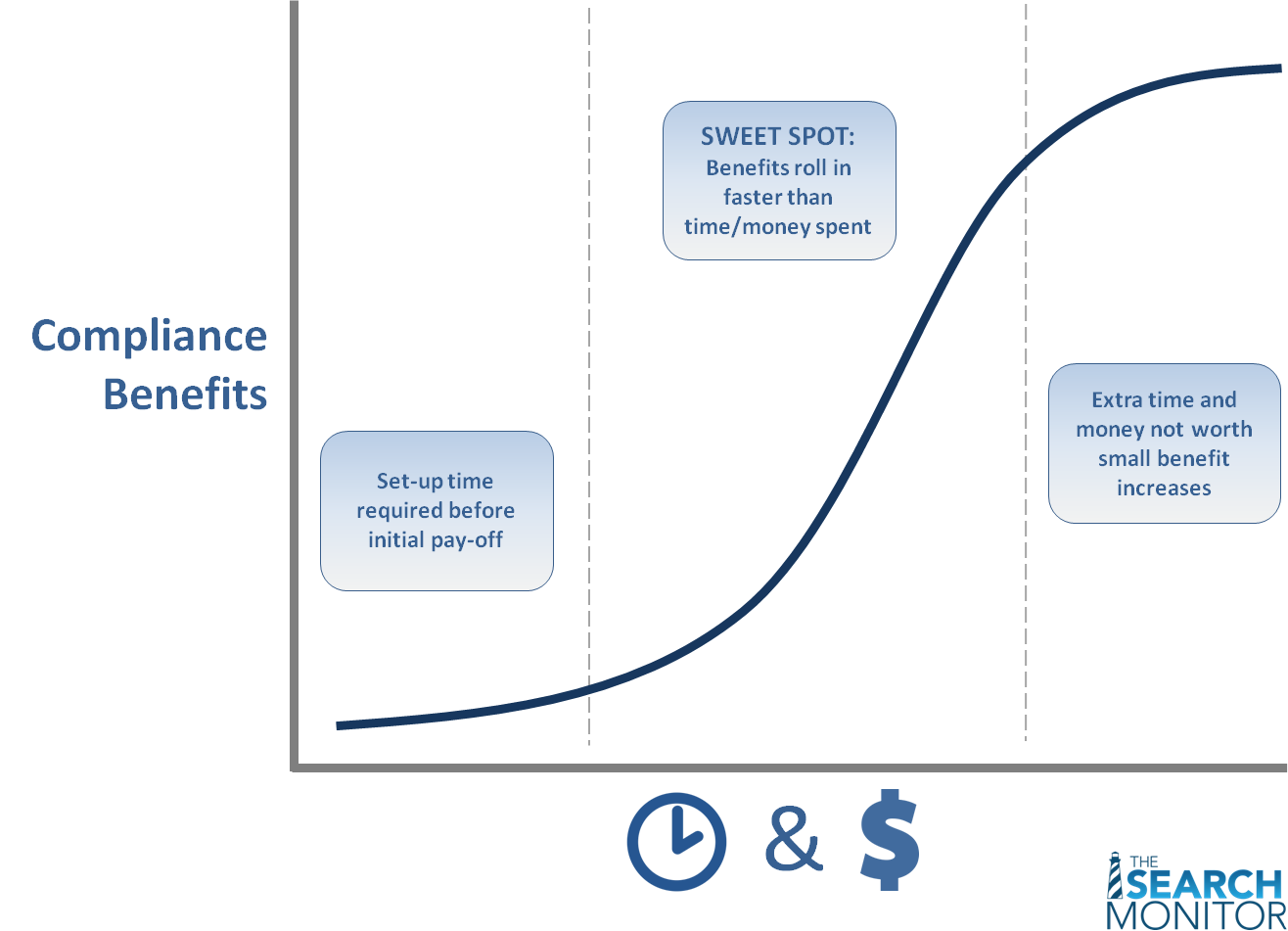The secret to compliance monitoring: Diminishing marginal returns
Nov 15, 2015
Affiliate Managers
 To be an effective marketing manager, you often have to think like a cop. Your job is to police rogue advertisers who are intentionally or unknowingly hurting your brand and marketing performance.
But policing the Internet requires a considerable amount of time, money, and skill to catch and deter the violators. Marketers are therefore faced with these questions:
To be an effective marketing manager, you often have to think like a cop. Your job is to police rogue advertisers who are intentionally or unknowingly hurting your brand and marketing performance.
But policing the Internet requires a considerable amount of time, money, and skill to catch and deter the violators. Marketers are therefore faced with these questions:
 Benefits from detecting compliance threats are initially small in relation to what you spend to get them. After all, it takes time and money to set-up and fine-tune an effective monitoring process. After this stage, you pass through a very attractive 'sweet-spot' zone where numerous significant violations are found and your investment is richly rewarded.
At this point it's tempting to scale your time and money commitment in hopes of detecting more meaningful compliance threats. But then you reach the third zone where the benefits gained are minimal compared to your time and budget investment.
Benefits from detecting compliance threats are initially small in relation to what you spend to get them. After all, it takes time and money to set-up and fine-tune an effective monitoring process. After this stage, you pass through a very attractive 'sweet-spot' zone where numerous significant violations are found and your investment is richly rewarded.
At this point it's tempting to scale your time and money commitment in hopes of detecting more meaningful compliance threats. But then you reach the third zone where the benefits gained are minimal compared to your time and budget investment.

- "How do I get the most value from monitoring my brand and affiliates?"
- "Do I really need to achieve zero tolerance for violations from my affiliates or against my brand?"
The Compliance Challenge
Answering these questions requires the same cost-benefit analysis you would perform with other marketing decisions. And similar to those analyses, you'll find that after a certain amount of time and money is invested, your benefits decrease sharply in relation to your investment. This is the concept of diminishing marginal returns. The chart below illustrates this relationship. Benefits from detecting compliance threats are initially small in relation to what you spend to get them. After all, it takes time and money to set-up and fine-tune an effective monitoring process. After this stage, you pass through a very attractive 'sweet-spot' zone where numerous significant violations are found and your investment is richly rewarded.
At this point it's tempting to scale your time and money commitment in hopes of detecting more meaningful compliance threats. But then you reach the third zone where the benefits gained are minimal compared to your time and budget investment.
Benefits from detecting compliance threats are initially small in relation to what you spend to get them. After all, it takes time and money to set-up and fine-tune an effective monitoring process. After this stage, you pass through a very attractive 'sweet-spot' zone where numerous significant violations are found and your investment is richly rewarded.
At this point it's tempting to scale your time and money commitment in hopes of detecting more meaningful compliance threats. But then you reach the third zone where the benefits gained are minimal compared to your time and budget investment.
The Tricky Third Stage of Diminishing Marginal Returns
Let's talk more about the third stage above. Why do benefits begin to decrease? It's in this stage where companies have finished focusing on their larger-volume keywords and move on to long-tail, low-volume terms. These keywords are much less important to the business but still consume significant time and financial resources. Examples of low-search-volume keywords include:- very-long-tail keywords searched only a few times per week
- keywords searched in only a few US markets or countries
- keywords running on smaller search engines.
Compliance Monitoring Tips From the Search Monitor
Here are tips from The Search Monitor's Compliance Monitoring Team to better focus your team's time and money:- Make sure your list reflects your business priorities. Look frequently at your keyword search volumes and remove the very low ones from you trademark and affiliate monitoring list. One examples would be keywords with bizarre type-os. (Contact us for more examples if what constitutes 'low'.)
- Do not aim for 'zero tolerance' for your violations. It's definitely acceptable to let certain violations go through.
- Identify the correct crawl frequency. With many small-to-mid-sized advertisers, the gains from increasing their crawl frequency from from 8 times a day to 12 or even 24 do not outweigh the added costs and increased violations you might find.
- Set up precise alert filters that make sense for your business. You don't want too few alerts, and miss out on serious violations, but you also don't want your team chasing down false positives produced by over-alerting
- Pay attention to the specific search engine. They're not all the same in terms of the logic they use to return results.
"We did all the steps right to set up alerts, but we didn't clean up the keyword list that triggered the alerts. After hours of researching the 30-40 alerts we were receiving each day and contacting the engines and affiliates to try to reproduce, we learned that the alerts were from searches performed 8 times in one quarter and from countries and engines we didn't focus on."












